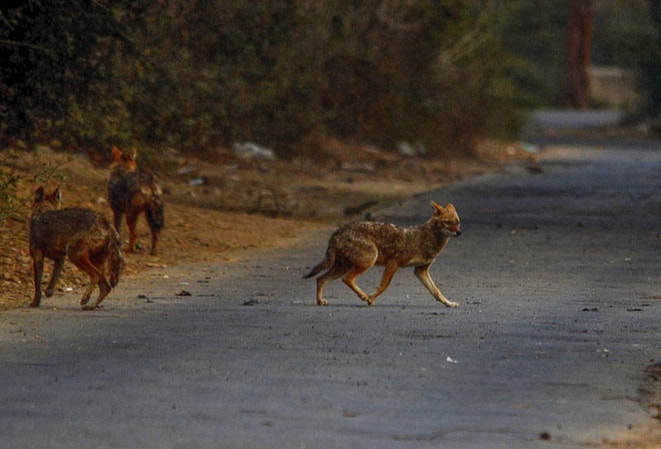|
Nishand Venugopal Jackals are the wild cousins of man’s best friend. Watching them in their habitat will give you an idea about how skillful they are. My first interesting interaction with one of these wild canids was when I visited Sultanpur National Park on a cold morning in January 2017. I never expected to see them there, but while exploring the terrain, I noticed a sudden movement near the grass. A pair of jackals was moving quickly towards the water body. It took me some time to identify them and a bit more to pull out my camera to take a photograph. One of them stopped for a while and turned back to look at me. It gave me a window of a few seconds to take a picture and I did just that! I was so surprised to see them at that time that I even forgot to zoom and take a better picture. I always assumed they live in wild areas but when I saw them again, a year after my first sighting in Sultanpur, I was surprised. I spotted a pack near Delhi, in a small pocket of vegetation surrounded by roads bustling with traffic. Three jackals were crossing the road looking on either side. It was as if they were well aware of the perils of crossing a path made by humans. They are probably trying to adapt to these kinds of changes. My next encounter with a jackal was not a fortunate one. The danger that the earlier pack was trying to avoid did not spare this unlucky animal. In March 2019, I came across a roadkill near the busy area of Dhaula Kuan, a busy traffic intersection in Delhi. I first thought it was a stray dog, but realized it was jackal upon taking a closer look. It is tragic to see such a beautiful species succumbing to human carelessness. Most people living in cities tend to be unaware of the wildlife around them. Jackals are still found in isolated, small pockets of wilderness which lack safe corridors. They continue to adapt to the hustle and bustle of human-made changes to their environment, and sometimes compete with their own feral cousins for subsistence and survival. There is immense need for creating awareness and empathy towards the species and their habitats. Jackals are presented as clever and sometimes shrewd characters in many children’s stories and in folklore. This adulation needs to translate to real life so as to prevent these magnificent wild canids from vanishing from their abodes.
8 Comments
Parvathi K. Prasad In the winter of 2016, I was assisting a team carrying out biodiversity surveys in Chikmagalur district of Karnataka. The district is known for being the origin of India’s coffee story, and for its scenic, biodiverse mountains, that form part of India’s Western Ghats. Lesser known, however, are the plains of Chikmagalur, that are spread across a substantial portion of the district, and also harbour a wide range of life forms. In winter, the numerous lakes that dot these plains turn into seasonal abodes for several migratory birds. One morning, I was out birdwatching with a small group of people. Amongst us was a student from Chikmagalur with a keen interest in natural history. The student claimed to have seen a fox in the area, during recent birdwatching trip. Unlike most carnivores that I had seen up until then, foxes are not forest-dwelling species. Grasslands and scrublands— typical habitats of the fox— enjoy little conservation attention. Often labelled ‘wastelands’, these habitats are easily diverted for infrastructure development, and are fast-disappearing in much of India’s countryside. During previous interactions with farmers in Karnataka, I had heard of occasional fox sightings in agricultural lands, but I had never seen a fox myself. Needless to say, I was thrilled with the prospect of seeing one– the pointy ears and bushy tail were certainly an additional draw! It was mid-morning when we headed to look for the fox. The area comprised of vast stretches of agricultural lands, mostly vegetables, while many a farmer was busy tending to the crops. We walked along a narrow pathway separating the fields, looking out for any signs of the animal. To me, it was remarkable that these canids used and navigated such dynamic spaces, likely feeding on rodents and keeping their numbers in check. A dried water channel meandered through the fields, and we walked up to it to casually. There, curled up in bundle was the grey, furry form of an Indian fox! It was resting in the channel, looking smaller than I had imagined it to be, the black tip of its bushy tail clearly visible. I remember my hands trembling with excitement as I slowly reached for my binoculars. We spent some time quietly looking at the fox and clicked a few photographs, all the while grinning from ear to ear. The fox then looked up at us with its beady eyes, not moving, but seemingly aware of our presence. Not wanting to disturb it, we walked away, extremely gratified with the encounter. To this day, it remains my only sighting of the beautiful animal. |


 RSS Feed
RSS Feed
